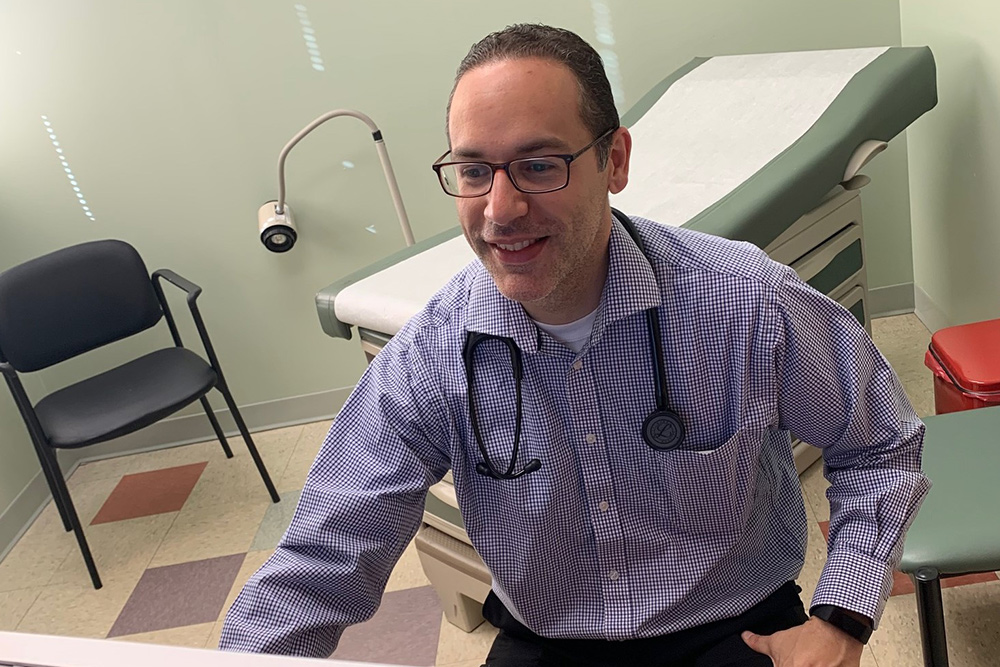
Though Connecticut boasted the lowest rate of COVID-19 transmission in the country at one point this summer, the novel coronavirus is still with us. As flu season approaches and colder weather forces people indoors, experts warn that it will be more important than ever to take the proper precautions to prevent the spread of both respiratory illnesses.
It’s also crucial, according to Israel Cordero, MD, Medical Director for Middlesex Health Primary Care, that patients don’t neglect other acute or chronic health care concerns, such as cardiac monitoring, diabetes check-ups, cancer follow-ups, immunizations, and preventive health screenings. “As long as your facility is taking appropriate precautions, you should prioritize your health and get these things taken care of,” says Dr. Cordero.
Ongoing research – and increased experience with the coronavirus over the course of the pandemic – continue to reveal new information about COVID-19 transmission, testing, treatment, and prevention. Seasons spoke with both Dr. Cordero and Middlesex Health’s Chief of Infectious Disease, Alina Filozov, DO, about what we know, what we don’t know, and how to best assess risk and stay healthy in the upcoming months.
What’s Safe, What’s Not
Is it safe to go to restaurants? To attend social events? To visit with family members who you don’t live with?
“It’s almost like a continuum of risks,” says Dr. Cordero. “It’s higher risk to be indoors than outdoors – it’s higher risk to eat indoors at a restaurant than to eat outdoors, for example. And I warn my high-risk patients that if they are congregating for some social event, it must be outdoors and everyone should be wearing masks or maintaining significant distance from others.”
Dr. Cordero notes that you don’t have to be ill or have an immune-compromising condition to be at higher risk for complications or even death from COVID-19. “Age alone puts you at risk,” he says. “Anyone above 60 is at higher risk, and for every 10 years older, the risk goes up significantly.”
Dr. Cordero says that many of his patients have asked whether it’s okay to get their hair or nails done. “It’s very hard in those businesses to maintain six feet of distance, so the people providing and receiving the services should be wearing masks – and wearing them appropriately, covering nose and mouth, at all times.” Barbershops and nail salons are fairly safe with masks, he says, “but if I were an 80-year-old, I wouldn’t have my hair done.”
Many patients also inquire about whether it’s safe to visit with grandchildren, according to Dr. Filozov. “We know that children can be asymptomatic carriers,” she says. “So try to do outdoor visits, wear masks, and keep your distance.” If family members can get tested first, and test negative, that would be the safest scenario, she adds. She also recommends relatives get tested before visiting a new baby in the family.

Dr. Filozov points out that are two types of risk to consider when assessing whether something seems safe. “One is the risk for acquiring the disease, and the other is the risk of having a severe illness as a result,” she says. “If you eat indoors in a restaurant, you can’t wear a mask while you’re eating. You eat and talk to each other, the air conditioning moves air around, so you are not in your ‘bubble’ – the air you breathe will be shared with the next table very quickly. If you take that risk, you have to understand that if you get sick and you are 70 – or especially 80 – and above, there is a high risk of severe illness and death.”
Both doctors stress the importance of masks as a preventive measure. “Masks protect you, and they protect others,” says Dr. Filozov. “Recent studies show a 75 percent decrease in transmission when both the person who is ill and the non-ill person wears a mask.” Because you can still infect other people even if you don’t have obvious symptoms, she says, everyone should be wearing masks.
However, she adds, while masks provide significant protection, they don’t eliminate the risk of transmission. “Therefore, masking has to accompany social distancing,” she says. Double layer, tight-fitting fabric masks and surgical masks are recommended for the public (surgical masks provide slightly more protection, but cloth masks are washable). N95 masks will filter more than 95 percent of COVID-19 particles, she says, but the wearer has to be fit tested to ensure the correct size, so this type of mask is intended for health care workers. (Keep in mind, Dr. Cordero adds, that surgical masks are no longer effective once wet and must then be discarded and replaced.)
Who should get tested?
“Now that testing has become more available, it’s a tool we should use when appropriate,” says Dr. Cordero. “But we shouldn’t overuse it, because we don’t have the capacity to test everyone.”
So when is it appropriate? “Anybody who has any contact with our health system on the inpatient side – whether they are having a baby or surgery or coming in for a health evaluation – gets tested,” he says. Testing is also available to those with and without COVID symptoms. Asymptomatic individuals might need to be tested because of exposure to the virus, because of travel, or for work or school.
Middlesex Health has a hybrid testing system in which asymptomatic patients can be tested in medical offices (primary care, family medicine, and infectious disease offices, as well as urgent care facilities in Middletown and Madison). An appointment is required. If testing is recommended for symptomatic patients, they will be directed to Middletown or Madison urgent care facilities locations.
The rapid tests that Middlesex uses on patients coming into the hospital and the nasal-pharyngeal test that it offers in its offices are both highly sensitive, according to Dr. Filozov. So if you have a positive test, it is most likely positive. But there is still a risk of false negatives in as many as 30 percent of cases, she says.
Similarly, positive antibody tests are much more reliable than negative ones. “And the antibodies have to be checked at the right time,” says Dr. Filozov.
“Usually, with other infectious diseases, we wait 7 to 10 days, but in this case, it takes close to 24 days for a patient to mount an antibody response. Five percent of those patients already recovered will not have detectable antibodies – the sicker you are, the higher the possibility that you will have the antibodies.”
The jury is still out on how long COVID-19 immunity lasts. “SARS immunity lasts from 3 weeks to 3 years,” says Dr. Filozov. Recent studies suggest that COVID-19 antibodies may dissipate in as few as 2 or 3 months, though whether patients retain other kinds of immunity to the novel coronavirus is still an unanswered question. “With COVID, we are going to have an answer this fall, as people aggregate more in indoor settings, there is more opportunity for transmission, and the virus starts circulating again.”
Unfortunately, COVID-19 is not going to be the only upper respiratory illness circulating this fall and winter. “It is super important to get a flu vaccine this season,” stresses Dr. Filozov. “Flu and COVID are going to be very challenging to differentiate because the most common COVID symptoms – fever, cough, runny nose, body aches, and gastrointestinal issues – are also classic flu symptoms. We are going to have to be testing people for both.”
Don’t neglect non-COVID care
“Telemedicine has played a critically important role in caring for our patients during this pandemic,” says Dr. Cordero. He says Middlesex Health is still trying to manage higher risk patients via virtual visits, but that patients with acute health problems and those in need of immunizations, preventive health checkups, and follow ups for chronic conditions should not be afraid to come to the office or the emergency room.
“The first thing I tell my patients is that, honestly, it is safer to come into my office than to go to Stop & Shop,” he says. “Not only do doctors screen out anyone with COVID symptoms 24 to 48 hours before any visit (those with symptoms are seen via a televisit), but we are pre-registering patients and doing intake over the phone, and if they are instructed to come in, patients call from the parking lot and are taken directly to an examining room. So we have essentially cut out the waiting room time.” Masks are required by staff and patients, social distancing is enforced, and offices are deep cleaned three times a day, he says. “Our offices are as sterile as the operating room.”
Dr. Cordero notes that during the peak of the pandemic, in-person visits dropped dramatically – including those to the emergency department. Even people having strokes and heart attacks were reluctant to come in. “Now we’re basically trying to tune up whatever has misaligned during this time, fix what hasn’t been taken care of,” he says. “We have a catch-up schedule for patients who are behind on immunizations, and we are doing all preventive health services, with the caveat that we don’t have high risk patients come in where risk outweighs benefits.”
Dr. Filozov says she is cautiously optimistic that a second wave will not be as severe as the first due to all of the restrictions in place. But she does expect that between flu and COVID-19, hospitals are likely to see a surge in cases of viral illness.
However, she says “we see very promising data on pending vaccines and treatment options. I anticipate to having more options in early 2021.”
Photo courtesy of Middlesex Health






More Stories
Happy Senior Hour for the Holidays
At Home With Kerri-Lee
A New, Free Peabody Museum Prepares for Opening